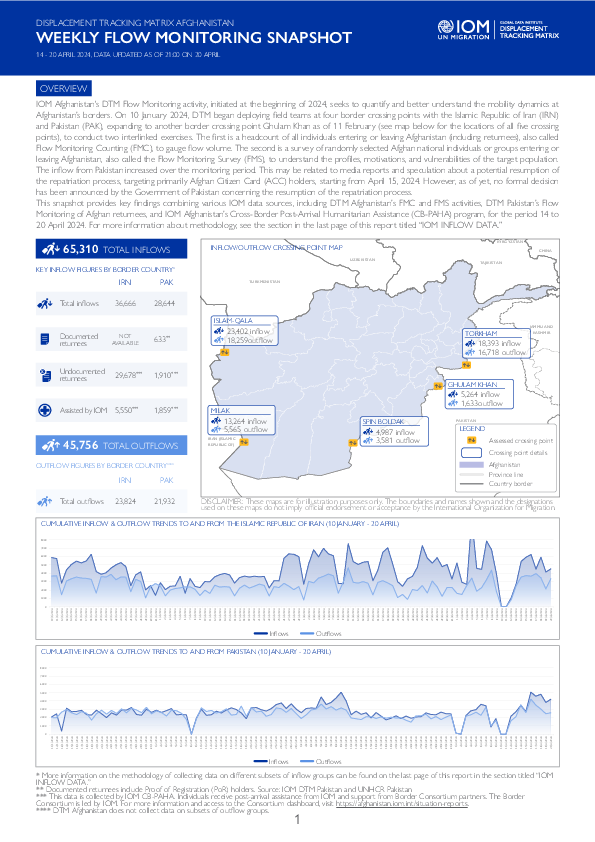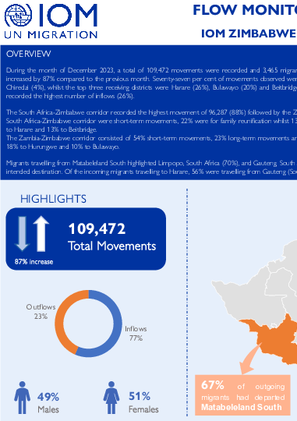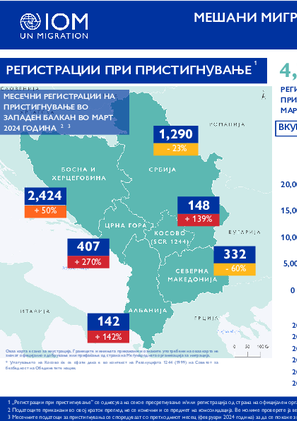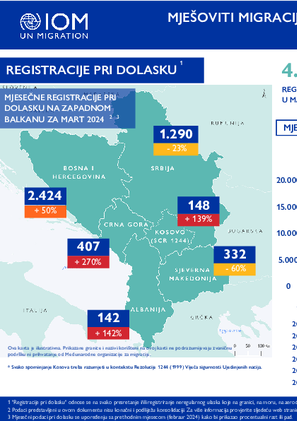-
Countries
-
Data and Analysis
-
Special Focus
-
Crisis Responses
Compilation/Overview
Color
white

Contact
DTM Zimbabwe, DTMzimbabwe@iom.int, DTMsupport@iom.int
Language
English
Location
Zimbabwe
Period Covered
Jan 01 2024
Jan 31 2024
Activity
- Flow Monitoring
During the reporting period a total of 62,339 movements were recorded and 3,811 migrants were interviewed across 38 Flow Monitoring Points (FMPs) in Zimbabwe. The total movements recorded decreased by 43% compared to the previous month. Sixty per cent of movements observed were inflows, whilst 40% were outflows. The top three sending districts were Beitbridge (41%), Harare (15%) and Chiredzi (10%), whilst the top three receiving districts were Harare (36%), Beitbridge (13%) and Bulawayo (9%). Matabeleland South province recorded the highest number of outflows (46%) whilst Harare province recorded the highest number of inflows (36%). The South Africa-Zimbabwe corridor recorded the highest movement of 49,574 (80%) followed by the Zambia-Zimbabwe corridor which recorded 7,975 (13%) movements. Forty-nine per cent of movements along the South Africa-Zimbabwe corridor were short-term movements, 28% were long term movements whilst 17% were for family reunification. Of the migrants travelling from South Africa, 30% travelled to Harare, 19% to Beitbridge and 11% were headed to Bulawayo. The Zambia-Zimbabwe corridor consisted of 58% short-term movements, 21% long-term movements and 20% family reunification movements. Of the migrants travelling from Zambia, 64% were travelling to Harare, 14% to Hurungwe and 7% to Gweru. Migrants travelling from Matabeleland South highlighted Limpopo, South Africa (51%), and Gauteng, South Africa (37%) as their intended destination. Those travelling to Botswana indicated Francistown (3%) as their intended destination. Of the incoming migrants travelling to Harare, 33% were travelling from Lusaka (Zambia), 28% from Gauteng (South Africa), and 14% from Eastern Cape (South Africa).
During the month of December 2023, a total of 109,472 movements were recorded and 3,465 migrants were interviewed across 38 Flow Monitoring Points (FMPs) in Zimbabwe. The total movements recorded increased by 87% compared to the previous month. Seventy-seven per cent of movements observed were inflows, whilst 23% were outflows. The top three sending districts were Beitbridge (64%), Harare (12%) and Chiredzi (4%), whilst the top three receiving districts were Harare (26%), Bulawayo (20%) and Beitbridge (11%). Matabeleland South province recorded the highest number of outflows (67%) whilst Harare province recorded the highest number of inflows (26%). The South Africa-Zimbabwe corridor recorded the highest movement of 96,287 (88%) followed by the Zambia-Zimbabwe corridor which recorded 8,588 (8%) movements. Sixty-two per cent of movements along the South Africa-Zimbabwe corridor were short-term movements, 22% were for family reunification whilst 13% were long-term movements. Of the migrants travelling from South Africa, 22% were going to Bulawayo, 22% to Harare and 13% to Beitbridge. The Zambia-Zimbabwe corridor consisted of 54% short-term movements, 23% long-term movements and 21% family reunification movements. Of the migrants travelling from Zambia, 55% were travelling to Harare, 18% to Hurungwe and 10% to Bulawayo. Migrants travelling from Matabeleland South highlighted Limpopo, South Africa (70%), and Gauteng, South Africa (18%) as their intended destination. Those travelling to Botswana indicated Central Province (4%) as their intended destination. Of the incoming migrants travelling to Harare, 56% were travelling from Gauteng (South Africa), 24% from Lusaka (Zambia), and 5% from Western Cape (South Africa).

Contact
DTM Zimbabwe, DTMzimbabwe@iom.int, DTMsupport@iom.int
Language
English
Location
Zimbabwe
Period Covered
Nov 01 2023
Nov 30 2023
Activity
- Flow Monitoring
During the month of November 2023, a total of 58,669 movements were recorded and 3,679 migrants were interviewed across 38 Flow Monitoring Points (FMPs) in Zimbabwe. The total movements recorded increased by 0.2% compared to the previous month. Sixty-eight per cent of movements observed were inflows, whilst 32% were outflows. The top three sending districts were Beitbridge (47%), Harare (16%) and Chiredzi (7%), whilst the top three receiving districts were Harare (30%), Beitbridge (12%) and Bulawayo (10%). Matabeleland South province recorded the highest number of outflows (52%) whilst Harare province recorded the highest number of inflows (31%). The South Africa-Zimbabwe corridor recorded the highest movement of 46,911 (80%) followed by the Zambia-Zimbabwe corridor which recorded 7,272 (12%) movements. Fifty-nine per cent of movements along the South Africa-Zimbabwe corridor were short-term movements, 20% were for family reunification whilst 20% were long-term economic movements. Of the migrants travelling from South Africa, 25% were going to Harare, 15% to Beitbridge and 9% to Bulawayo. The Zambia-Zimbabwe corridor consisted of 53% short-term movements, 24% family reunification movements and 22% long-term movements. Of the migrants travelling from Zambia, 54% were travelling to Harare, 15% to Bulawayo and 13% to Hurungwe. Migrants travelling from Matabeleland South highlighted Limpopo, South Africa (69%), and Gauteng, South Africa (19%) as their intended destination. Those travelling to Botswana indicated Central Province (3%) as their intended destination. Of the incoming migrants travelling to Harare, 35% were travelling from Gauteng (South Africa), 30% from Lusaka (Zambia), and 13% from Eastern Cape (South Africa).

Contact
DTM Ukraine, dtmukraine@iom.int
Language
English
Location
Ukraine
Period Covered
Nov 27 2023
Dec 27 2023
Activity
- Other
Since the full-scale invasion of Ukraine in February 2022, the country has confronted profound economic disruptions alongside widespread displacement. With millions seeking safety and stability, the challenges of maintaining livelihoods, securing employment, and accessing social protection are paramount, necessitating focused interventions to mitigate economic hardships.
This report examines the economic ramifications of the war in Ukraine, focusing on changes in income levels, employment trends, and social assistance measures. Drawing on data from the IOM General Population Survey (GPS), this report aims to support evidence-based programming, policy-making, advocacy, and further research on the subject.

Contact
DTM Niger, NigerDataResearch@iom.int
Language
French
Location
Niger
Period Covered
Jan 01 2023
Dec 31 2023
Activity
- Survey
- Flow Monitoring Survey
- Flow Monitoring
- Migrants presence
- Mobility Tracking
La mobilité humaine à destination, ou à travers le Niger constitue un phénomène aux multiples dimensions et variétés. Elle comprend la transhumance, les migrations saisonnières liées à la période des récoltes, les voyages durant les fêtes religieuses, le tourisme, la migration économique vers le nord et l'ouest de l'Afrique, la recherche d'emploi, les déplacements imposés par les conflits, les catastrophes naturelles ou les effets du changement climatique, ainsi que l'exode rural. Ces éléments illustrent la diversité de la mobilité observée au Niger et dans la région de l'Afrique de l'Ouest et du Centre.
Ce rapport, élaboré à partir de données collectées de sources primaires et secondaires, vise à tracer un portrait des tendances et dynamiques migratoires du Niger, pour mieux saisir leur complexité et examiner les interactions entre les différents types de mouvements à travers le pays.
Bien que non exhaustif, ce document cherche à donner une vue d'ensemble sur la mobilité au Niger, tout en esquissant les profils des individus qui participent à ces mouvements.

Contact
DTMAfghanistan@iom.int
Language
English
Location
Afghanistan
Period Covered
Apr 14 2024
Apr 20 2024
Activity
- Survey
- Flow Monitoring Survey
- Flow Monitoring
IOM Afghanistan's DTM Flow Monitoring activity, initiated at the beginning of 2024, seeks to quantify and better understand the mobility dynamics at Afghanistan’s borders. On 10 January 2024, DTM began deploying field teams at four border crossing points with the Islamic Republic of Iran (IRN) and Pakistan (PAK), expanding to another border crossing point Ghulam Khan as of 11 February (see map below for the locations of all five crossing points), to conduct two interlinked exercises. The first is a headcount of all individuals entering or leaving Afghanistan (including returnees), also called Flow Monitoring Counting (FMC), to gauge flow volume. The second is a survey of randomly selected Afghan national individuals or groups entering or leaving Afghanistan, also called the Flow Monitoring Survey (FMS), to understand the profiles, motivations, and vulnerabilities of the target population. The inflow from Pakistan increased over the monitoring period. This may be related to media reports and speculation about a potential resumption of the repatriation process, targeting primarily Afghan Citizen Card (ACC) holders, starting from April 15, 2024. However, as of yet, no formal decision has been announced by the Government of Pakistan concerning the resumption of the repatriation process.
This snapshot provides key findings combining various IOM data sources, including DTM Afghanistan’s FMC and FMS activities, DTM Pakistan’s Flow Monitoring of Afghan returnees, and IOM Afghanistan’s Cross-Border Post-Arrival Humanitarian Assistance (CB-PAHA) program, for the period 14 to 20 April 2024. For more information about methodology, see the section in the last page of this report titled “IOM INFLOW DATA.”

Contact
DTM Nigeria, iomnigeriadtm@iom.int
Language
English
Location
Nigeria
Period Covered
Nov 16 2023
Dec 18 2023
Activity
- Survey
The aim of the survey was to shed light on the voices and aspirations of IDPs regarding their preferred durable solutions within the next 12 months or one year, to facilitate evidence-based decision-making, and policy and programme planning around durable solutions. A durable solution is achieved when IDPs no longer have any specific assistance and protection needs that are linked to their displacement and can enjoy their human rights without discrimination on account of their displacement. The intentions such as ‘return to the place of origin’, ‘integrate into the current location’, or ‘relocate to a new location’ which were assessed during the survey were indicative of the preferred Solutions of IDPs.
The survey brought to light that a large portion (37%) of the respondents intend to return to their place of origin. Also, almost the same proportion of the respondents intended to integrate into their current location (38%). The largest number of respondents who expressed their desire to return were in Borno State. Similarly, most of the respondents who wished to integrate because of the security situation were good in their current location. Regionally, the respondents in the LGAs towards the west of the region were more inclined to integration compared to those LGAs towards the northern parts. The survey also revealed that two per cent of the respondents prefer to relocate to another LGA or state. The majority of those who intended to relocate preferred the LGAs within their state of current displacement.
Месечен преглед на:
- Пристигнувања во Западен Балкан
- Топ три националности на лица кои пристигнале во месецот на известување
- Присуство на мигранти во прифатните објекти
- Доброволно асистирано враќање и реинтеграција
Mjesečni pregled:
- Dolasci na Zapadni Balkan
- Tri najzastupljenije nacionalnosti u izvještajnom mjesecu
- Prisustvo migranata u prihvatnim centrima
- Potpomognuti dobrovoljni povratak i reintegracija
Përmbledhje mujore të:
- Arritjet në Ballkanin Perëndimor
- Tre kombësitë kryesore të arriturëve
- Prania e migrantëve në qendrat pritëse
- Kthimet vullnetare dhe të asistuara
Pagination
- Previous page
- Page 8
- Next page



